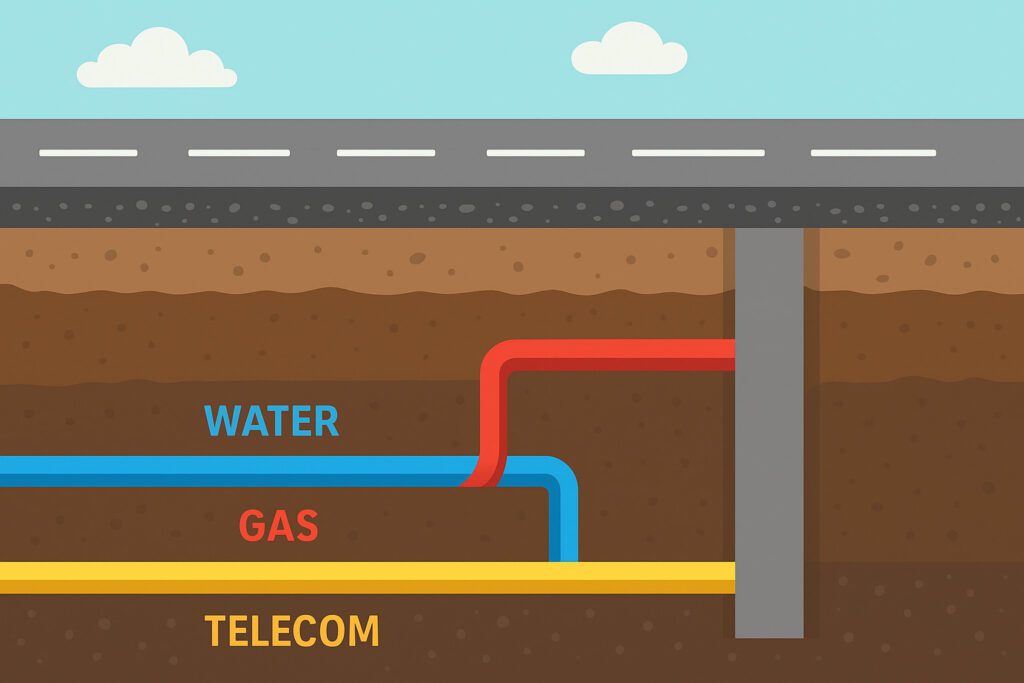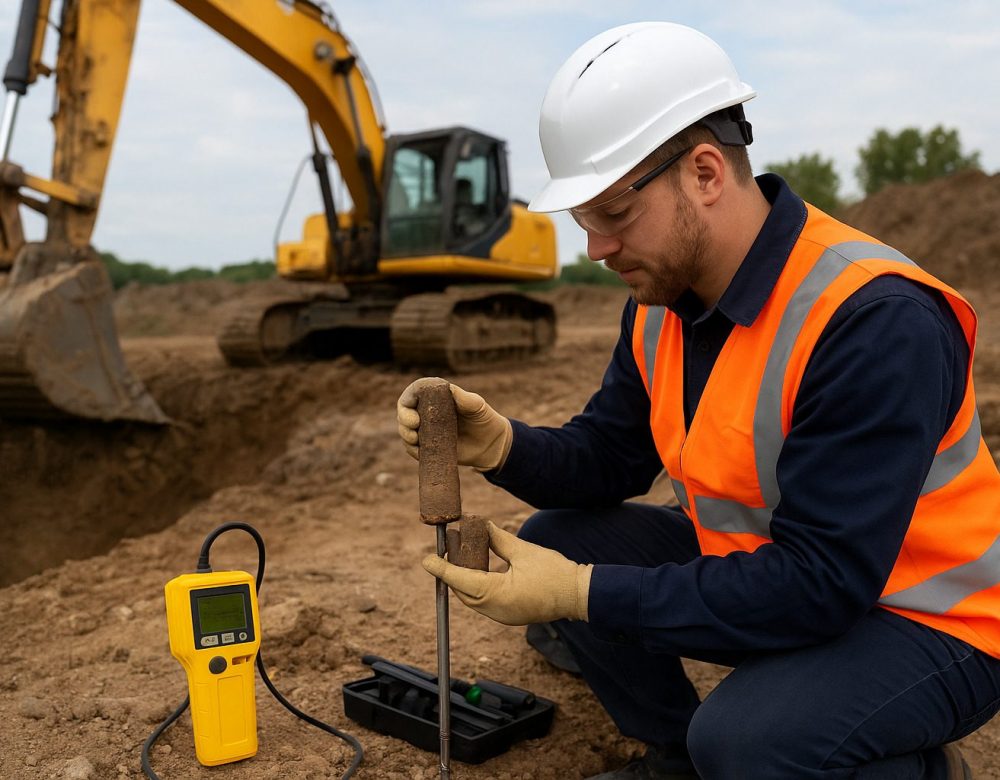Every construction project begins with what lies beneath the surface. The stability of the ground determines the strength of everything built upon it. That’s where geotechnical engineering steps in, blending science, engineering, and practical experience to ensure that soil, rock, and structure work together safely and efficiently. For complex civil, heavy, and underground construction, geotechnical insight is more than a technical requirement. It’s the foundation of success, safety, and, when disputes arise, accountability.
At Discovery Experts, our team applies decades of engineering and forensic experience to help clients understand ground conditions, prevent costly failures, and provide clarity when litigation requires expert analysis. This article explores how geotechnical engineering connects to real-world site inspections, risk mitigation, and expert witness services across the construction industry.
Understanding Geotechnical Engineering and Its Role in Construction
What Geotechnical Engineering Involves
Geotechnical engineering isn’t just about testing dirt. It’s about predicting how the ground will behave when it’s asked to bear the weight of roads, buildings, tunnels, and infrastructure. Engineers examine soil mechanics, rock behavior, slope stability, and foundation design, all to determine how well a site can handle the demands of construction. In heavy and underground projects, this knowledge is the difference between stability and collapse.
For example, consider a major civil infrastructure project that requires deep excavation. Without understanding how groundwater interacts with the soil layers, a small miscalculation could lead to erosion, settlement, or worse, a structural failure. Geotechnical engineers provide the analysis that prevents such outcomes, guiding decisions before the first shovel ever hits the ground.
Why Subsurface Analysis Matters
Beneath the surface lies a story of pressure, moisture, and movement. Subsurface analysis tells that story. Soil testing and data modeling reveal how stable the earth will be once it’s disturbed by construction. This information drives smarter project planning and avoids the kinds of surprises that turn into multimillion-dollar disputes. When done correctly, geotechnical reporting helps ensure structural longevity and protects everyone involved, from contractors to property owners.
For projects involving underground installations like trenchless construction or utility tunneling, subsurface knowledge is non-negotiable. Understanding the layers of earth ensures that cables, pipelines, and foundations can be placed safely and efficiently without triggering settlement or collapse.
Site Inspection Practices in Civil and Underground Projects
What Happens During a Construction Site Inspection
Every construction site inspection tells a story about the health of a project. These inspections are not box-checking exercises; they’re a safeguard against structural and financial disaster. A geotechnical site inspection often includes reviewing excavation conditions, verifying soil compaction, assessing groundwater presence, and ensuring compliance with engineering specifications. Each observation matters, even a small deviation can indicate a potential future claim or safety concern.
In civil and underground projects, inspectors also assess trench support systems, erosion control, and how site activity aligns with approved engineering plans. This proactive approach ensures that the project stays aligned with safety standards and avoids rework or penalties later. A consistent inspection schedule helps everyone, from project managers to insurers, sleep a little better at night.
Identifying Common Risks in Underground Environments

Working underground comes with its own set of risks. Think of trench collapses, shifting soil, or unmarked utilities, these issues can jeopardize lives and equipment in seconds. For projects involving telecommunications, gas lines, or fiber optics, precision is everything. Proper geotechnical oversight can help avoid conflicts between existing utilities, maintain soil stability, and ensure compliance with OSHA trench safety standards.
In addition, inspectors document every stage of underground work. That documentation is invaluable not only for immediate corrections but also if questions arise later during dispute resolution or insurance review. When an issue arises months after project completion, a well-documented inspection log can make the difference between a quick settlement and prolonged litigation.
Geotechnical Engineering in Heavy Construction and Infrastructure
Integrating Geotechnical Data into Project Design
In heavy construction, success starts with communication. Geotechnical data should never live in isolation from design teams. By sharing soil analysis and foundation reports early in the planning process, engineers, contractors, and project owners can align expectations and reduce risk. Integrating this data ensures that materials, equipment loads, and foundation systems are compatible with the ground conditions beneath them.
This coordination is particularly important for infrastructure like bridges, pipelines, and deep foundations. Without it, design assumptions may fail under real-world stress. Geotechnical collaboration prevents that disconnect and strengthens both the structural and financial integrity of a project.
Case Examples: Lessons from the Field
Imagine a large commercial site where early foundation cracks appeared just months after construction. Investigations revealed that soil consolidation had been underestimated in the initial report. A detailed geotechnical review, conducted post-failure, helped determine the true cause, and ultimately saved the client millions in potential claims. It’s scenarios like this where expert analysis proves its worth.
At Discovery Experts, our engineers often assist attorneys, contractors, and insurers in understanding complex failure mechanisms. Whether it’s analyzing a sinkhole, reviewing heavy equipment operation during construction, or evaluating soil stability reports, we translate technical data into clear, defensible findings for legal and professional audiences.
Expert Witness Insight: When Geotechnical Failures Lead to Disputes
Common Legal Scenarios
When things go wrong underground, the consequences are rarely minor. Common disputes arise from foundation movement, trench collapses, and structural instability caused by improper compaction or poor drainage. In many cases, the question isn’t just “what happened” but “who is responsible.” That’s where a geotechnical engineering expert witness can make all the difference.
These experts evaluate evidence, analyze reports, and clarify the technical story behind a failure. Their testimony helps attorneys and adjusters understand whether the root cause was design-related, environmental, or due to construction practices. It’s a process that blends science, engineering, and communication to ensure a fair resolution.
The Expert’s Role in Litigation Support
A skilled expert witness doesn’t just present facts; they explain them. Through detailed analysis, written reports, and courtroom testimony, they make complex engineering principles understandable. At Discovery Experts, we offer geotechnical engineering expert witness services for civil and underground cases. Our approach balances technical depth with clarity, ensuring that every conclusion is supported by evidence and sound methodology.
Whether supporting arbitration or preparing for trial, our goal is to help legal teams make informed decisions backed by credible engineering expertise. When projects face scrutiny, an experienced voice grounded in real-world engineering can make all the difference.
Best Practices for Geotechnical Site Inspections
What separates a good inspection from a great one? Consistency and detail. Effective site inspections involve more than observation, they rely on structured processes that verify design intent and identify problems early. Inspectors should maintain comprehensive records, including photographs, field logs, and soil test data. Even minor anomalies, when documented properly, can provide critical context later.
Some of the best practices include:
- Reviewing subsurface and design data before fieldwork begins.
- Using standardized digital inspection forms for accuracy and traceability.
- Communicating findings immediately to the project engineer or manager.
- Archiving reports securely for future reference or legal review.
These steps may sound simple, but in high-stakes projects, they build trust and transparency. For underground utility or trenchless installations, these logs can later serve as key evidence in resolving disputes over workmanship or compliance.
Conclusion: Strengthening Construction Integrity Through Geotechnical Expertise
At its core, geotechnical engineering is about foresight. It’s about understanding how the unseen elements of a construction site influence everything above it. By combining strong engineering practices with meticulous site inspections, project teams can prevent failures, strengthen safety, and maintain integrity from the ground up.
In today’s complex construction environment, this expertise also plays a growing role in litigation and claims support. Whether you’re managing a major infrastructure project or facing a construction dispute, Discovery Experts provides the technical insight and professionalism needed to navigate both the science and strategy of construction challenges.
Learn more about our Civil, Heavy, and Underground Construction Inspection Services or contact our team to discuss your next project, case, or technical evaluation. Your foundation for clarity begins here.

